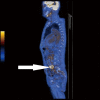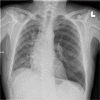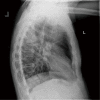What do we know about pulmonary blastoma?: review of literature and clinical case report
- PMID: 28008207
- PMCID: PMC5159477
- DOI: 10.18999/nagjms.78.4.507
What do we know about pulmonary blastoma?: review of literature and clinical case report
Abstract
Pulmonary blastoma (PB) is a rare form of lung tumour and is accountable for 0.25-0.5% of primary pulmonary malignancies. Initially pulmonary blastoma was divided into three subtypes: biphasic pulmonary blastoma (BPB) consisting of an epithelial and mesenchymal component, well differentiated fetal adenocarcinoma (WDFA) built of well differentiated epithelium and a mesenchymal component and malignant pleuropulmonary blastoma (PPB). Prognosis in this type of cancer is really poor. We present a current review of literature and a clinical case report. Treatment of PB is very difficult. Data and recommendations about the treatment of pulmonary blastoma are still available therefore we should use only observations and clinical case reports.
Keywords: blastoma pulmonary; chronic kidney disease; lung cancer.
Figures










References
-
- Barnett N, Barnard W. Some unusual thoracic tumors. Br J Surg, 1945; 32: 441–457.
-
- Jethava A, Dasanu C. Adult biphasic pulmonary blastoma. Conn Med, 2013; 71: 19–22. - PubMed
-
- Spencer H. Pulmonary blastomas. J Pathol Bacteriol, 1961; 82: 161–165.
-
- Travis W, Brambilla E, Muller-Hermelink H, Harris C. World Health Organization classification of tumors: pathology and genetics of tumors of the lung, pleura, thymus and heart. IARC Press: Lyon; 2004. - PubMed
LinkOut - more resources
Full Text Sources
